MXA RACE TEST: THE REAL TEST OF THE 2023 KTM 300SX TWO-STROKE
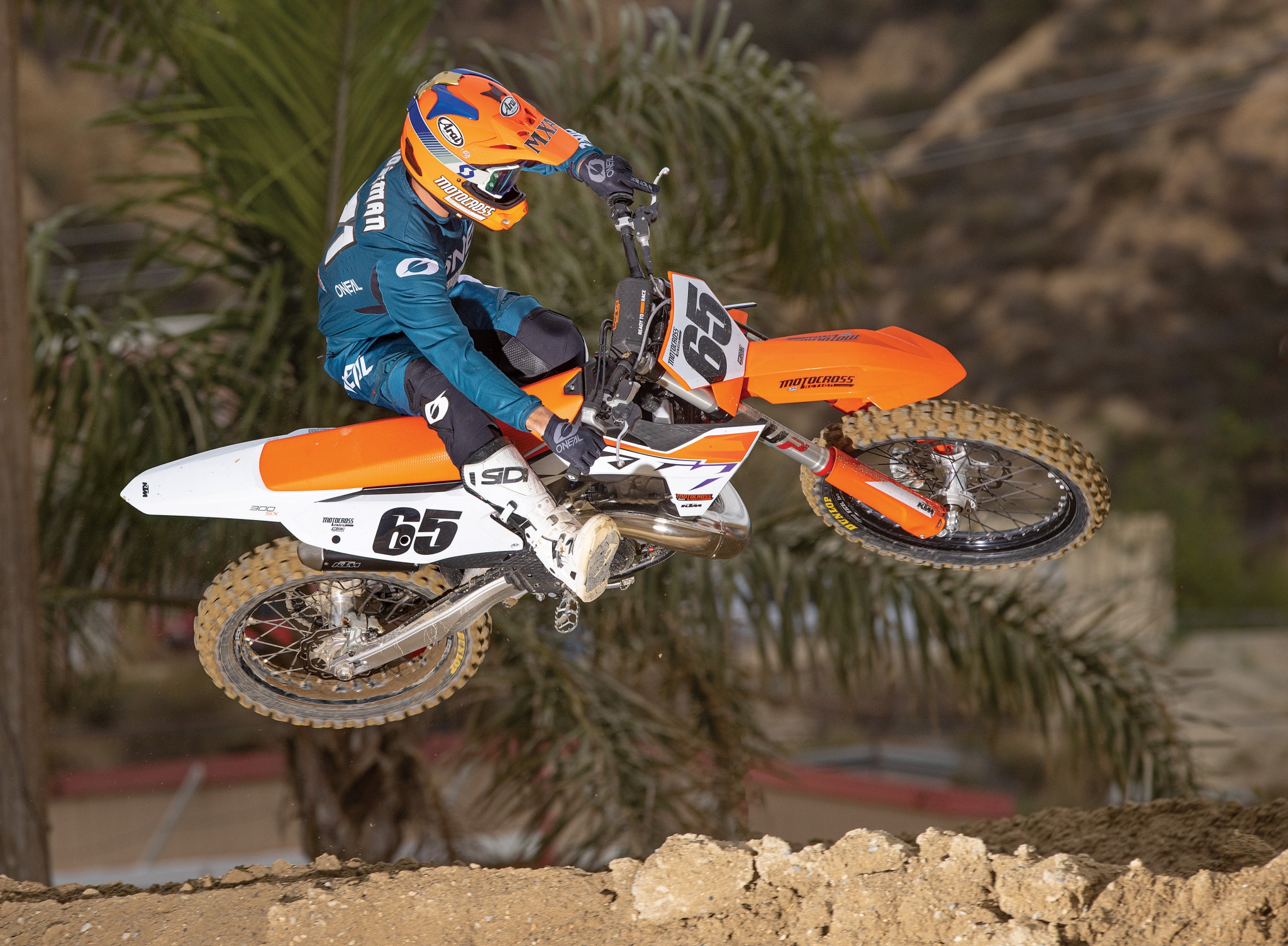 THE GEAR: Jersey: O’Neal Hardwear, Pants: O’Neal Hardwear, Helmet: Arai VX-Pro4, Goggles: Scott Fury, Boots: Sidi Atojo.
THE GEAR: Jersey: O’Neal Hardwear, Pants: O’Neal Hardwear, Helmet: Arai VX-Pro4, Goggles: Scott Fury, Boots: Sidi Atojo.
Q: FIRST AND FOREMOST, IS THE 2023 KTM 300SX BETTER THAN THE 2022 MODEL?
A: The 2023 KTM 300SX is an all-new model for the “Ready to Race” brand. The SX tag at the end of the model designation indicates that this 300, actually a 293, is one of KTM’s motocross-specific bikes; however, KTM sold 300cc two-strokes prior to 2023, but they had always been off-road-specific bikes. The KTM 300XC is a very popular fuel-injected cross-country two-stroke model, but it’s not the same as the new 300SX. The XC model uses Transfer Port Injection (TPI) fuel-injection instead of the new Throttle Body Injection (TBI) system that comes on the 300SX. The TPI technology has been on the off-road two-strokes since 2018, but now KTM and Husky have introduced the next generation of fuel-injection on their 2023 two-strokes, and they’ve brought it to the motocross realm.
Q: WHAT’S NEW ON THE 2023 KTM 300SX?
A: The KTM 300SX inherited the all-new frame, subframe, swingarm, rear shock and plastics from the 2023 KTM four-strokes. We’ve gone into detail about the stiffer chromoly steel frames and other updates to the chassis in our other 2023 KTM bike tests, but our focus in this 300SX two-stroke test is the engine and fuel-injection technology. Here are the highlights.
(1) Bore/stroke. The 2023 KTM 300SX is built on the 2023 250SX model’s architecture, only with a bigger bore in the cylinder. The 250SX has a 66.4mm bore with a 72mm stroke. The 300SX shares the same bottom end as the 250SX, but the 72mm big-bore stroke delivers 43 extra cubic centimeters in the cylinder delivers 43 extra cubic centimeters of displacement.
(2) Fuel injection. The traditional Mikuni TMX carburetor, with its main jet, pilot jet, needle and air screw found on 2022 and earlier-model KTM 250SX two-strokes, was replaced with a 39mm Keihin throttle body equipped with dual injectors to moderate the fuel/air ratio going into the combustion chamber.
(3) ECU. KTM added an electronic control unit on the 300SX to act as the dirt bike’s “brain” and determine the optimal air/fuel mixture needed for temperature, humidity, and altitude.
(4) TPS. A throttle position sensor was added to work together with the ECU, power valve and fuel-injection system.
(5) Power valve. Another piece of electronic wizardry for 2023 is the electric power valve. The power valve is opened by an electric motor connected to gears. Yamaha also uses an electric power valve but uses a cable. Previously, the KTM power valve was spring loaded. Now, the power valve opens and closes based on throttle position and engine rpm.
(6) Map switch. The electronic power valve made it easy for KTM to add two map options on the 300SX; however, the two-strokes don’t have traction control or Quick Shift like the 2023 four-strokes.
(7) Electric start. The new 2023 KTM 300SX has an E-start. It doesn’t fire up as quickly as the four-stroke, though. Just as with your carbureted two-stroke, you need to give it a little gas when pressing the E-start button.
Q: WHO IS THE 2023 KTM 300SX MADE FOR?
A: The 2023 KTM 300SX is made for riders looking for big power at a low overall weight. It’s made for professional practice riders who don’t mind that you can’t race this bike in the 450cc class at the National level, but nothing stops it from competing at most local events. It’s made for riders who want the lug-ability of a 450 four-stroke with beautiful-sounding, two-stroke music. It’s made for Vet riders who compete in age group classes without a displacement limit. And, it is custom made for two-stroke-only classes like the World Two-Stroke Championship.
Prior to 2023, the KTM PowerParts catalog sold a 300cc big-bore kit, which was very popular. The kit was used by factory Red Bull KTM riders Ryan Dungey and Cooper Webb at the Red Bull Straight Rhythm and has been adopted by riders competing in Vet classes and two-stroke open classes. Even though the 300cc two-stroke isn’t eligible to race in 450 Nationals or Supercross classes, there’s still a large market of riders who desire the 300SX, and KTM is capitalizing on that this year. For the 2023 season, the Yamaha YZ450F has been the most highly anticipated bike, but the KTM 300SX is clearly the second most popular bike of the year. Everyone wants to know how this bike runs on the track.
 The 2023 KTM 300SX is a brand-new bike for KTM. They’ve made 300cc off-road two-strokes before, but this is the first 300cc motocross-specific bike.
The 2023 KTM 300SX is a brand-new bike for KTM. They’ve made 300cc off-road two-strokes before, but this is the first 300cc motocross-specific bike.
Q: HOW DOES THE FUEL-INJECTED ENGINE DIFFER FROM THE CARBURETED ENGINE?
A: No carburetor, no main jets, no needles, no clips and no pilot jets are the most obvious differences. The acronyms EFI, ECU, EMS, CDI, TPS, TPI and TBI are now standard nomenclature on modern bikes. EFI stands for electronic fuel injection. ECU stands for electronic control unit. EMS stands for engine management system. CDI stands for capacitor discharge igniter. TPS stands for throttle position sensor. TPI stands for transfer port injection, and TBI stands for throttle body injection.
The Austrian’s new, highly sophisticated fuel-injection system delivers a perfect air/fuel ratio for instantaneous, controllable power at all times, truly broadening the horizon for usable power on a two-stroke. The 300SX is much more friendly off the crack of the throttle than a traditional carbureted KTM two-stroke. It rolls into the power in a smooth and linear manner, making it much easier to ride. Carbureted two-stroke engines require skill to maintain the proper rpm and keep the engine in the sweet spot. The new 300SX has a four-stroke-like powerband that picks up instantly without lag. Once fuel-injected four-strokes came into their prime, it became easier for riders to lug their bikes in corners and hit the throttle for instant response.
Unlike with Transfer Port Injection (TPI) KTM off-road bikes, you have to put premixed fuel in the tank, as the motocross 300SX does not have oil injection.
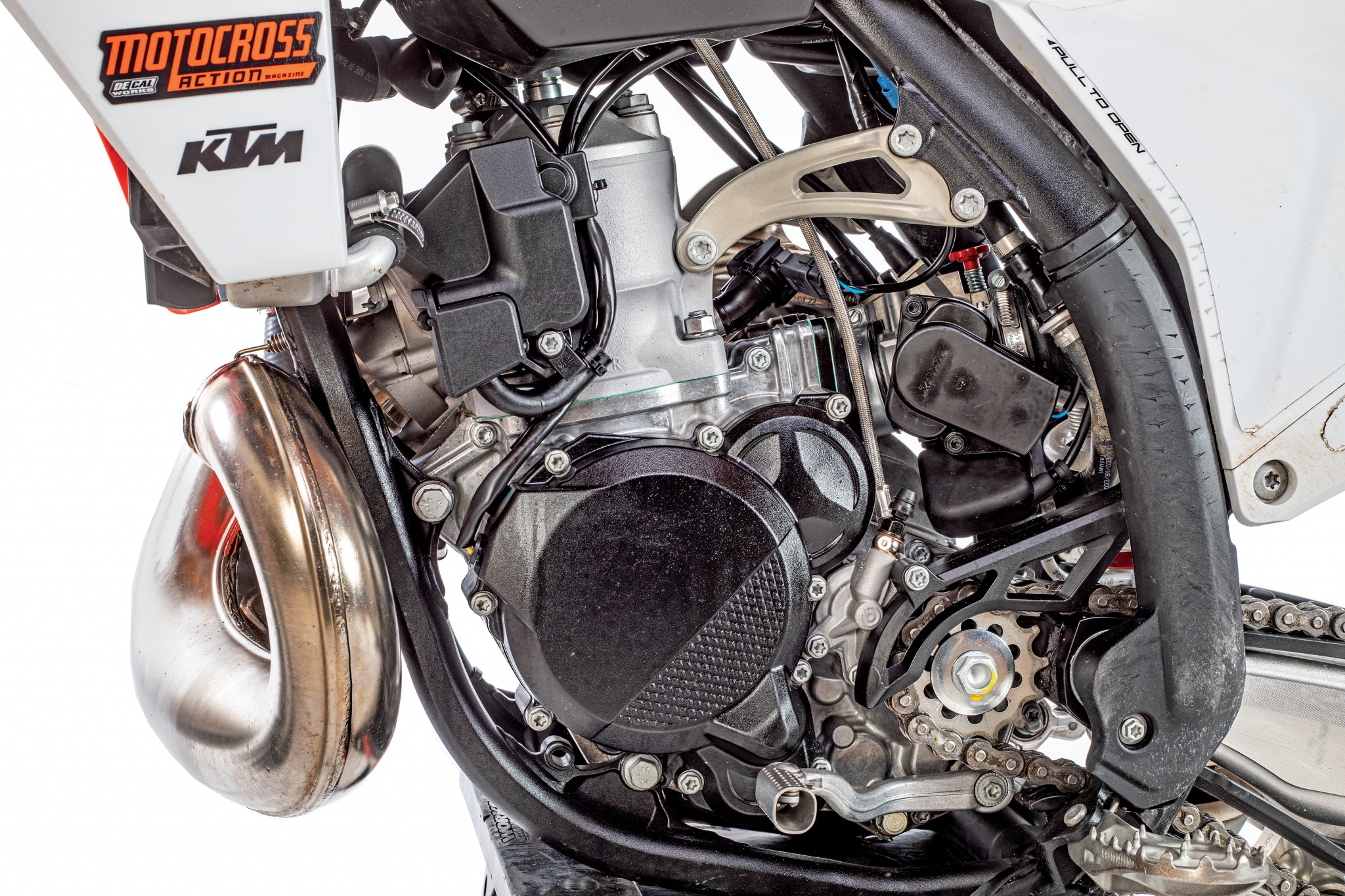 Gone are jets, needle and air screws. In there place is fuel injection and an ECU-controlled electric power valve. Oh yeah, it also has electric start.
Gone are jets, needle and air screws. In there place is fuel injection and an ECU-controlled electric power valve. Oh yeah, it also has electric start.
Q: HOW DOES THE KTM 300SX RUN ON THE TRACK?
A: The KTM 300SX is masterful in the corners. Because of its smooth, roll-on power, our test riders were able to navigate every type of turn with ease. Typically, tighter, off-camber and technical corners would be more of a challenge on a two-stroke, but the instant pick-up gave our testers more manageable power right away.
In the midrange, the 300SX comes on strong. The extra 50cc is noticeable in that you don’t have to shift as much as you do on the 250SX. It’s easier to lug second gear in the tight turns and third gear in the sweeping corners, and you don’t have to shift as quickly down the straights. In its stock form, the 300SX is exceptionally fast, allowing you to pull a wheelie at will and easily clear any jump in front of you.
Our biggest complaint with the new fuel-injected two-strokes from KTM and Husqvarna is the rev limiter. Rev limiters are far from normal on two-strokes. With carburetors directing a fixed amount of fuel and air into the combustion chamber, we never had to worry about a rev limiter. When over-revved, two-stroke engines eventually run out of fuel, they still try to make power. Now, with the ECU controlling how much fuel and air goes into the combustion chamber, the rev limiter is set to protect the engine from going beyond its intended rpm range.
When we quizzed the KTM engineers about the new two-stroke rev limiter, they explained that fuel-injection technology allows the engine to rev up much quicker than a traditional carburetor, which in turn requires a rev limiter to protect it from going too far. The big benefit of fuel-injection is instant power on the bottom end, while the downside is the rev limiter on the top end; however, after learning more about the rev limiter, we realized that it typically kicks in when we pull the clutch in and rev the bike, or when we rev the bike mid-air. When we’re on the ground and the engine is under a load, it is much harder for it to hit the rev limiter.
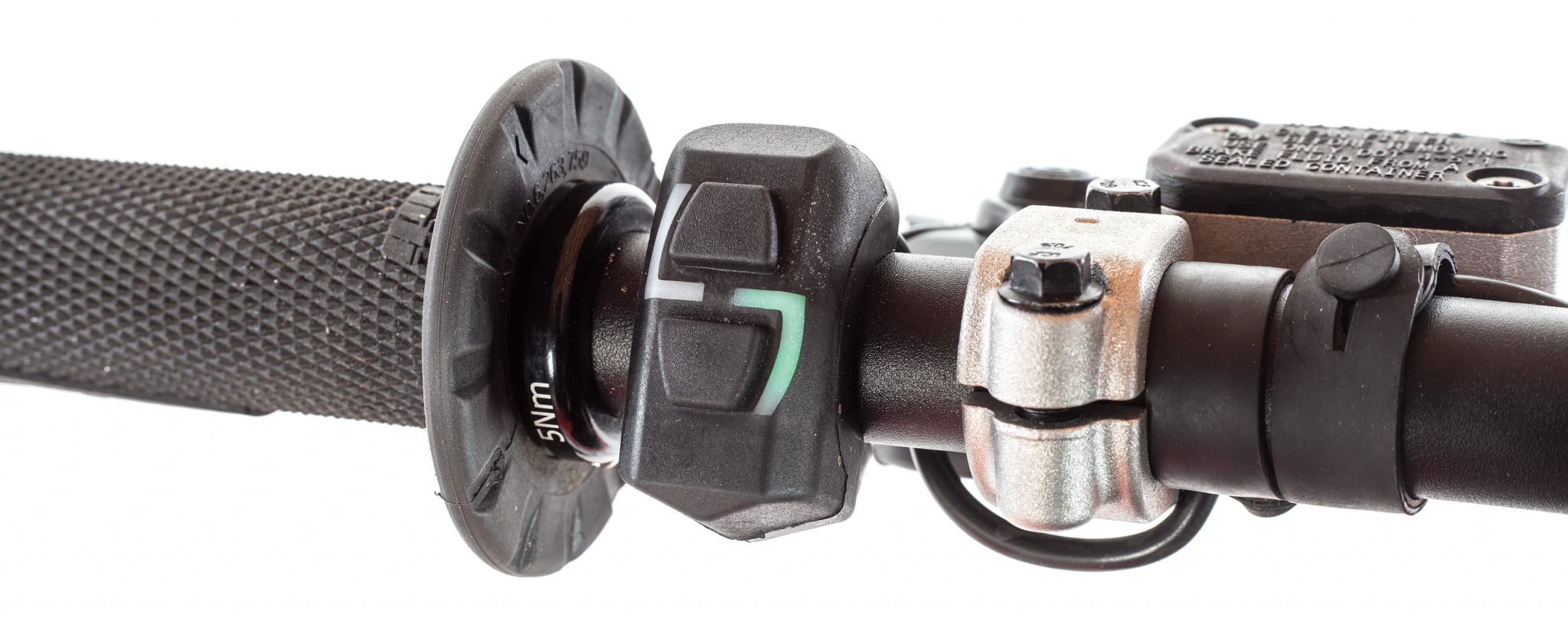 The 300SX comes with a map switch. The white button illuminates for Map 1 and the green button for Map 2.
The 300SX comes with a map switch. The white button illuminates for Map 1 and the green button for Map 2.
Q: HOW ARE THE STOCK MAPS ON THE NEW KTM 300SX?
A: The 300SX gained the same map switch as the KTM four-strokes (minus Traction Control and Quick Shift availability). Map 1 is illuminated by a white light, and Map two lights up green. In Map 1, the power valve only opens 80 percent, which creates a mellower power delivery. In Map 2, the power valve opens all the way, giving you access to all 300cc of glory. Our test riders felt that Map 1 was easier to manage in the tighter sections, while Map 2 was faster and more exciting all the way through the rpm range.
Q: CAN YOU ADJUST THE MAPPING ON THE 2023 KTM 300SX?
A: Up until recently, riders had the ability to re-map a stock KTM ECU to customize the power characteristics to their skill level. Unfortunately, KTM changed their ECU system starting on the 2021-1/2 models, which has made it impossible for tuners to access so far. Currently, KTM, Husky, GasGas, Honda, Kawasaki and Suzuki all use Keihin ECUs on their bikes, while Yamaha uses their own proprietary unit. Right now, Vortex has the technology to replace the Keihin and Yamaha systems, but they don’t have the ability to tap into the new 2023 Austrian two-strokes yet, because those ECUs are made by a company called Continental. For now, Vortex doesn’t plan to develop ECUs for these bikes and our only hope is for tuners like Twisted Development to crack the code on the new system.
Q: HOW DOES THE KTM 300SX RUN ON THE DYNO?
A: The 2023 KTM 300SX has a smooth and linear dyno curve which gets started showing the 300SX producing 27-horsepower at 5000 rpm. By 6000 rpm it makes 34-horses, it jumps to 39-horses at 6500 rpm, 45 at 7000 rpm and just over 50-horsepower at 7500 rpm. Long story short, the 300SX comes on with authority, making some serious power down low. The steep climb in power starts to lessen after 7500, but it’s still climbing. At 8500, the 300SX peaks at 55.0-horsepower in map 2, which just barely edges out the Suzuki RMZ450 in peak power.
Surprisingly, with map 1 only opening the power valve 80-percent, the dyno chart doesn’t show such a big difference. The power curve is idenitcal between map 1 and 2 up until 6700 rpm when map 2 slighlty separates itself. Still, map 1 sticks right behind and peaks at 54.19-horsepower. Comparing these numbers to the 2023 Husqvarna TC250 fuel-injected two-stroke, the 300SX is almost three horsepower stronger. The TC250 also has a linear power curve and it peaks at 52.12-horsepower at 8600 rpm. Further comparison shows the 2023 KTM 450SXF is 5-horsepower stronger on peak power and it pulls to 9800 rpm, which is 1300 further than the 300SX.
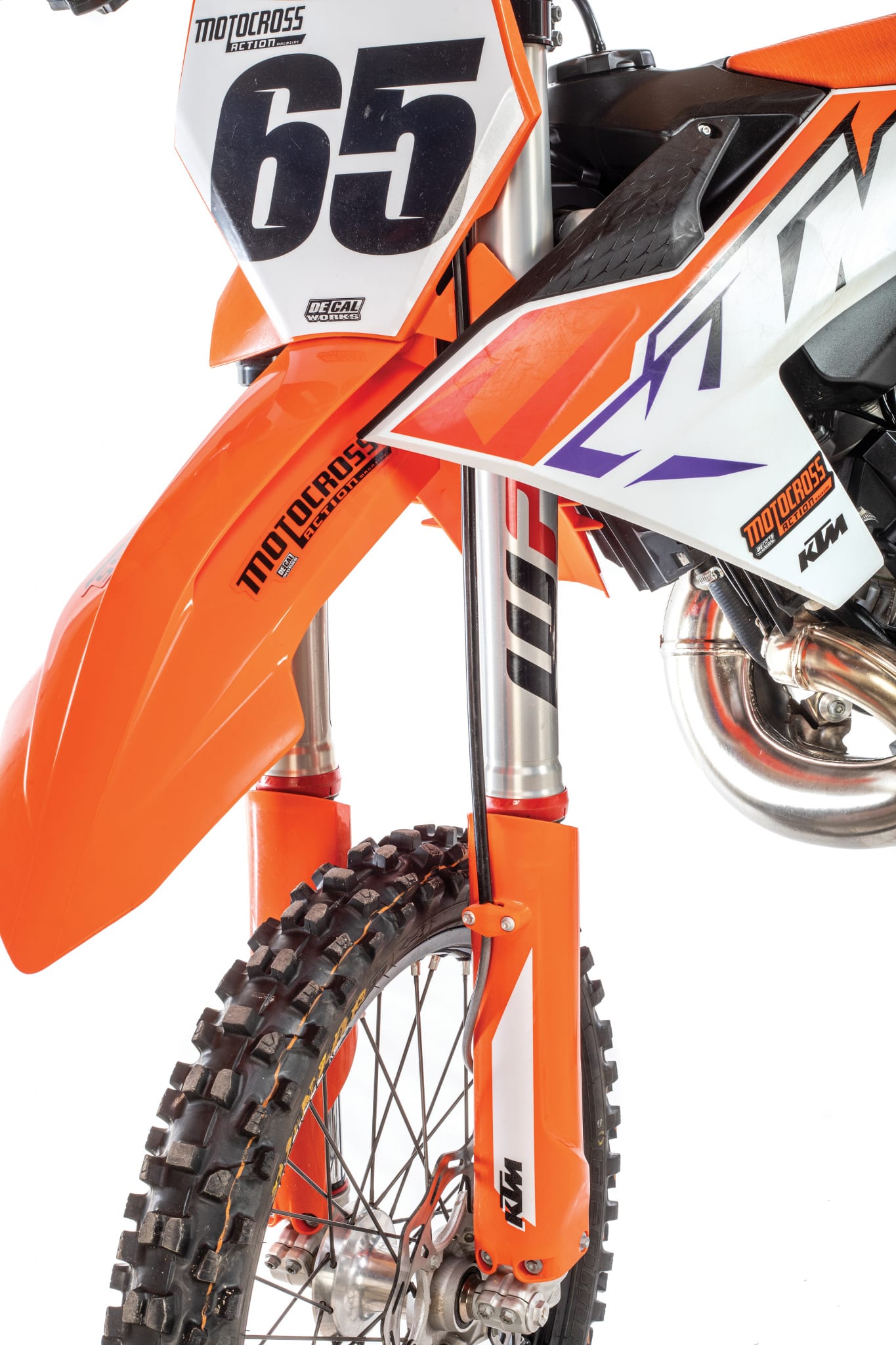 MXA test riders can make the WP XACT air forks work by understanding how they work. They can be tuned to riders of different sizes and skill levels.
MXA test riders can make the WP XACT air forks work by understanding how they work. They can be tuned to riders of different sizes and skill levels.
Q: HOW IS THE WP SUSPENSION?
A: It often seems that we are the only test riders who are consistently impressed with the WP XACT air forks. That could be because we test and race up to 25 different WP XACT-equipped models every season. We take the time to set them up for each test rider. Ever since the new oil and air bypass bleed holes, trampoline valve and longer cross-over slot were added in 2021, we’ve had a ball with these forks.
Our 150-pound Vet riders, 170-pound Pro riders and 190-pound intermediate riders all felt comfortable on this suspension. Yes, our 150-pounders would have benefited from a 42 N/mm shock spring, but they still found confidence with the stock 45 N/mm setup. With the WP air forks, each rider is able to custom tune the fork to his liking based on air pressure and then manage the compression and rebound damping with the adjustable-by-hand clickers on the top and bottom of the right-side fork leg.
When riding the 300SX back-to-back with the 2023 Husqvarna TC250, we felt the KTM’s suspension held up much stronger with its stiffer valving and full-length forks and shock.
Q: HOW DOES THE 300SX HANDLE ON THE TRACK?
A: Thankfully, it didn’t take as long to break-in the 300SX as it did to break in our 2023 KTM 450SXF. With the stiffer chromoly steel frame on the 450SXF, it took 10 hours for us to finally get comfortable, but the 300SX was comfortable after less than two hours of break-in time. We’re guessing it’s the combination of softer suspension, a lighter engine, and the two-stroke powerband that made the 300SX so much easier to ride out of the box.
On the track, the 300SX is stable at speed and handles stutter and braking bumps with ease. With the new chassis and the new engine position within the frame, the KTM 300SX squats much less under acceleration and doesn’t pitch as much coming into turns. With the big-bore 300cc engine, our test riders noticed that it felt slightly harder to initiate corners on the 300SX than on a 250 two-stroke. The extra inertia of the big-bore piston meant slightly more effort was required to dip into turns. Overall, the KTM 300SX was a lot of fun to ride. It has a balanced feel coming in and out of turns that allows you to put more power to the ground on exit and stop quicker on entrance.
 The new radiator cap looks cheap. After staring at it for a while, we realized it’s similar to the one on the KTM minis. It was hard to remove because of it tight confines and small size.
The new radiator cap looks cheap. After staring at it for a while, we realized it’s similar to the one on the KTM minis. It was hard to remove because of it tight confines and small size.
Q: WHAT DID WE HATE?
A: The hate list:
(1) Spokes. KTM claimed to have made their spokes stronger for 2023, but they’re not any better than before. Keep a close eye on them.
(2) ECU. We hate that the stock ECU is locked, and we hate even more than Vortex doesn’t have an assembly line running for this bike yet.
(3) Radiator cap. The plastic radiator cap is no good. It lacks leverage because of its small diameter. You have to push down on it to get it to turn, and that isn’t easy given the tight confines.
(4) Aesthetics. KTM went backwards with its bodywork configuration. Now you have to remove the rear fender to take the side number panels off.
(5) Wheel spacers. Unlike on the last 20 years of KTMs, you cannot run your older spare rear wheel on the 2023 model without changing the seals and spacer tube.
(6) Shock linkage. On an undetermined number of KTMs, the needle bearings walk out of the linkage and bind it up. We replace the stock needle bearings with a new caged bearing (KTM part number 58033097000).
(7) Rev limiter. We’re having a hard time getting used to a rev limiter kicking in every time the rear wheel catches air.
Q: WHAT DID WE LIKE?
A: The like list:
(1) Fuel injection. The EFI system blessed the 300SX with a power that is ultra-smooth and easy to use.
(2) Suspension. The WP XACT suspension is great for a wide range of riders (once you find your perfect air pressure).
(3) Brakes. Brembo makes the best brakes, period.
(4) Power valve. The new electric power valve contributes to the smooth power and looks like the internals of a Swiss watch in action.
(5) Maps. We’re thankful to have two map options on the 300SX, even though we stayed in Map 2 most of the time.
(6) Shock collar. The new shock collar works better and smoother than the previous design. Thank you, WP!
(7) Electric starting. It is true that we could live without the magic button, but since the battery was there anyway for the other components, we discovered that we have been seduced by the fact that every other bike we ride has push-button starting.
 Gone are jets, needle and air screws. In there place is fuel injection and an ECU-controlled electric power valve.
Gone are jets, needle and air screws. In there place is fuel injection and an ECU-controlled electric power valve.
Q: WHAT DID WE REALLY THINK?
A: The $9199 KTM 300SX lives up to the hype. It is ultra-fast, ultra-smooth and ultra-stable. Because the bike is so fast and so comfortable out of the box, we think many riders will be happy with the stock setup and won’t feel the need to add on oodles of aftermarket upgrades.
 The 300SX benefits from the same chassis as the 2023 four-stroke models from KTM.
The 300SX benefits from the same chassis as the 2023 four-stroke models from KTM.
MXA’S 2023 KTM 300SX SETUP SPECS
This is how we set up our 2023 KTM 300SX for racing. We offer it as a guide to help you find your own sweet spot.
WP AIR FORK SETTINGS
We always recommend using a zip-tie to find your correct air pressure setting. Once you find the air pressure number that brings your forks to within 1-1/2 inches from bottoming, start focusing on the compression clicker until you’re comfortable. For hardcore racing, we recommend this fork setup for the 2023 KTM 300SX.
Air pressure: 10.5 bar (154 psi)
Compression: 12 clicks out (for Intermediate and Pro), 16 clicks out (for slower or lighter riders)
Rebound: 12 clicks out (14 clicks out for slower or lighter riders)
Fork height: 2nd line
Notes: As a rule of thumb, don’t start playing with your air pressure or clicker settings until you set the sag for your weight, check the tire pressure, and bleed the air out of the little Torx head bolt on both fork caps. Also, on a hot day, your forks will gain pressure over time. Check the pressure periodically throughout the day. We’re confident that you’ll love the WP XACT suspension if you take the time to find your personal air pressure number.
WP REAR SHOCK SETTINGS
The WP XACT rear shock is easy to feel comfortable on. For hardcore racing, we recommend this shock setup for the 2023 KTM 300SX (stock specs are in parentheses):
Spring rate: 45 N/mm
Hi-compression: 1-1/2 turns out (2 turns out)
Lo-compression: 14 clicks out
Rebound: 14 clicks out
Race sag: 105mm
Notes: The stock KTM 300SX settings are stiffer than the 250 two-stroke settings on the Husqvarna and GasGas bikes. The good news is that these settings have plenty of hold-up for experienced riders, which means that a wide range of riders won’t have to send their suspension off for a re-valve; however, if you’re under 155 pounds or over 190 pounds, you might need to swap out the shock spring accordingly.


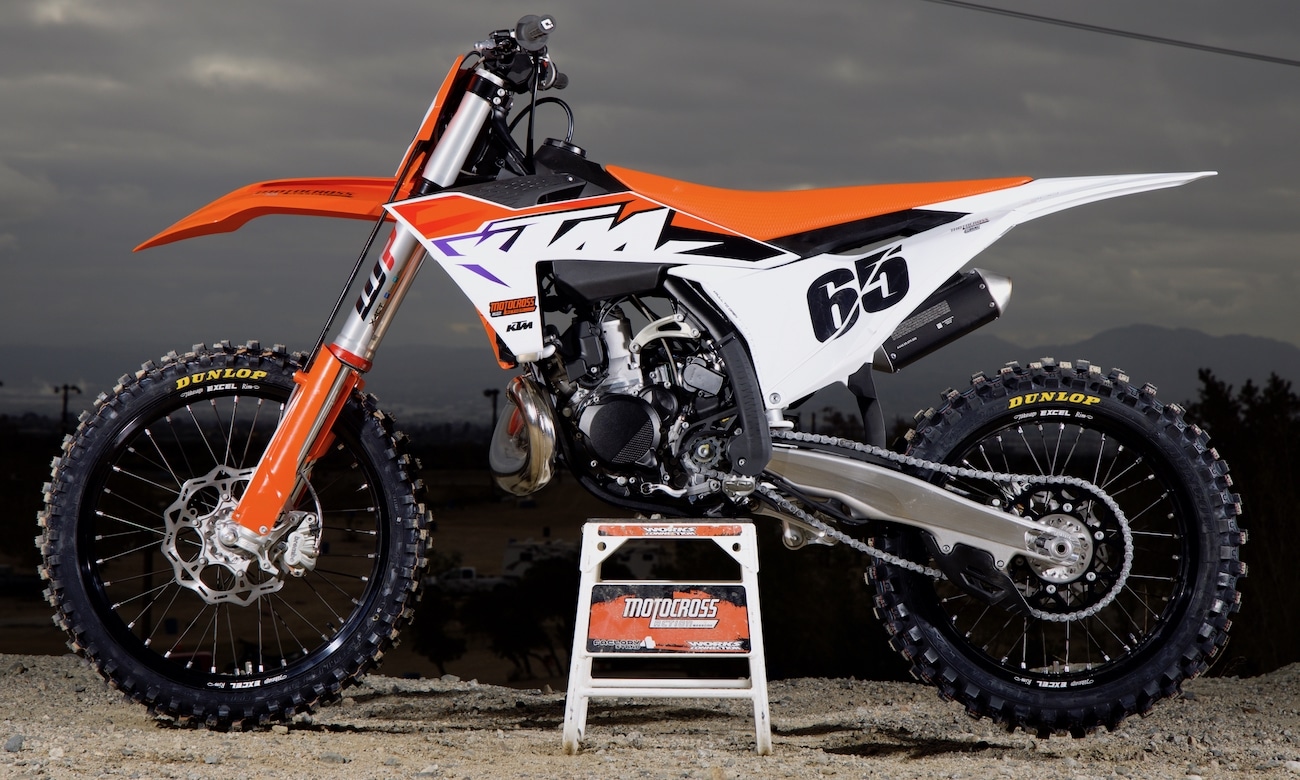
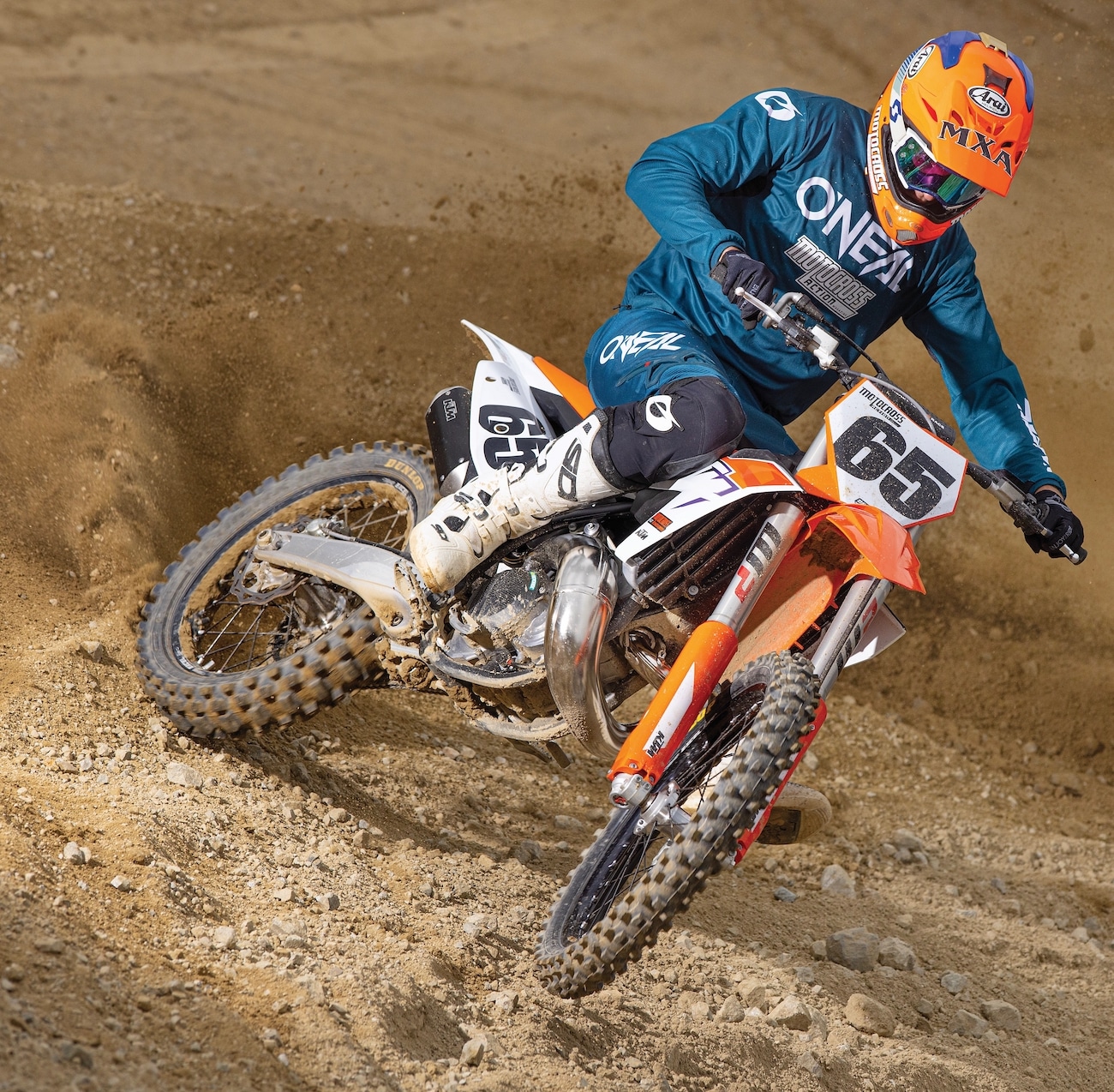

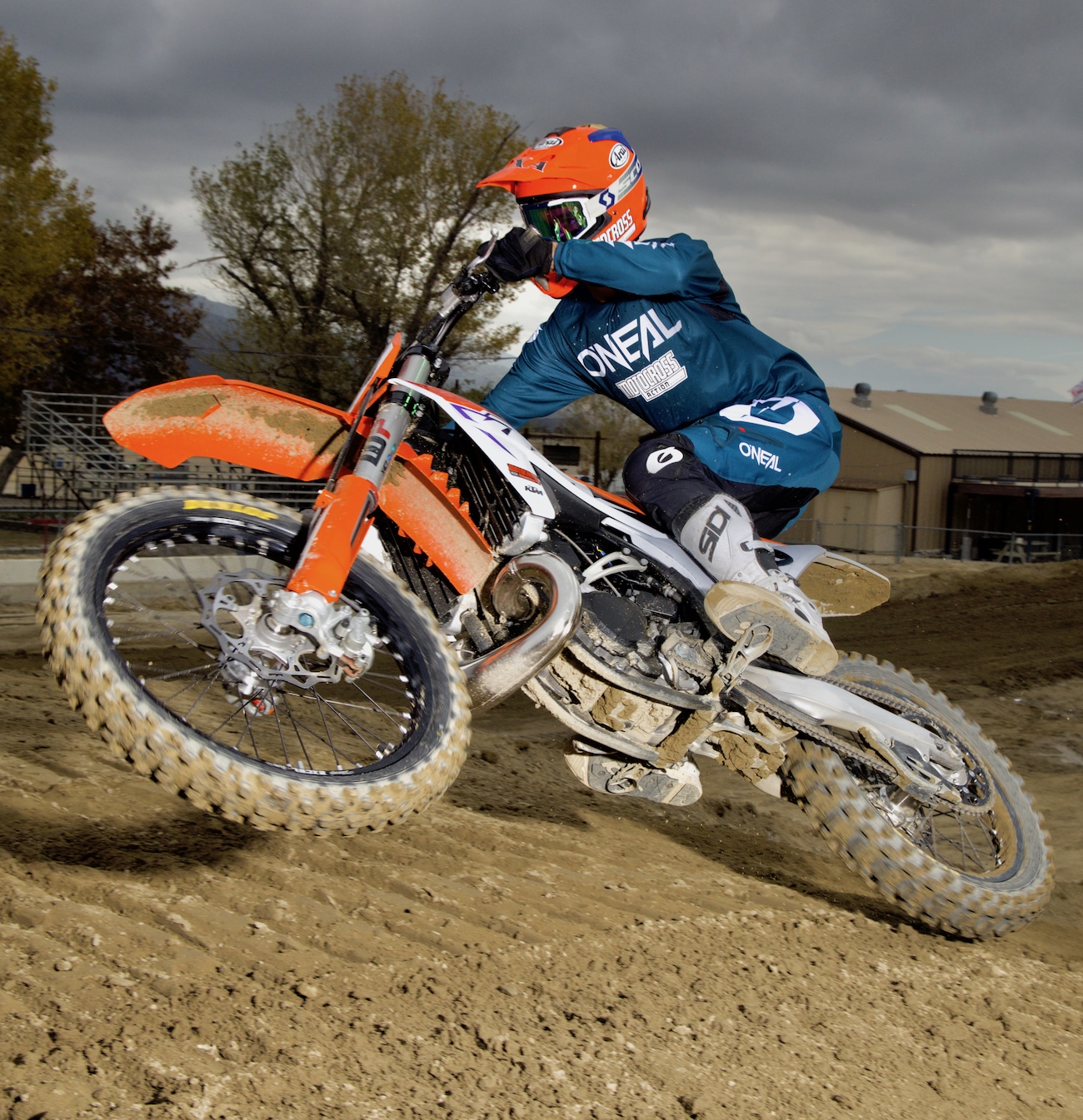


Comments are closed.